| NOVEMBER 2019 |
|
5 shows in T˘ky˘ (Kabukiza, National Theatre, Theatre Cocoon, Shinbashi Enbuj˘), 2 in Kitakyűshű (Heisei Nakamuraza), 1 in Toyooka (Eirakukan) and 1 in Yamaga (Yachiyoza)!
|
| Kabukiza (T˘ky˘) |  |
| Dates | 1 ~ 25 November 2019 Kichirei Kaomise ďkabuki Annual Festive Face-Showing Grand Kabuki |
| MatinÚe | |
| Evening | |
| Casting |
Living National Treasure Onoe Kikugor˘, Living National Treasure Kataoka Hidetar˘, Nakamura Tokiz˘, Nakamura Shikan, Matsumoto K˘shir˘, Nakamura Baigyoku, Nakamura Kaishun, Nakamura Ganjir˘, Ichikawa Sadanji, Ichikawa Danz˘, Onoe Sh˘roku, Band˘ Takesabur˘, ďtani Tomoemon, Kataoka Ichiz˘, Band˘ Hikosabur˘, Band˘ Kamez˘, Nakamura Kikaku, Kawarasaki Gonjűr˘, Ichimura Manjir˘, Nakamura Baishi, Nakamura Kangyoku, Ichikawa Sai'nyű, Ichimura Kakitsu, Band˘ Shűch˘, Matsumoto Kingo, Ichikawa Komaz˘, Sawamura Yoshijir˘, Ichikawa Somegor˘, ďtani Hirotar˘, Nakamura Mantar˘, Nakamura Jűjir˘, Ichimura Kitsutar˘, Ichimura Hikaru, Onoe Ushinosuke |
| Comments |
The traditional November kaomise programs at the Kabukiza, which celebrates the shűmei of Nakamura Kangyoku.
|
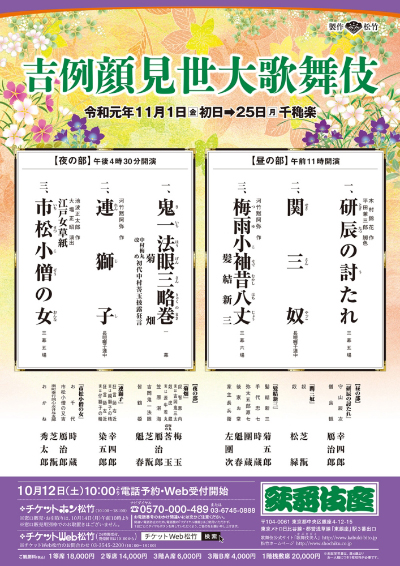 |
| National Theatre (T˘ky˘) |
| Dates | 3 ~ 26 November 2019 |
| Program |
Kok˘ no Yűshi Musume Kagekiyo (Hyűgajima) |
| Casting |
Living National Treasure Nakamura Kichiemon, Living National Treasure Nakamura T˘z˘, Nakamura Jakuemon, Nakamura Kinnosuke, Nakamura Karoku, Nakamura Matagor˘, Nakamura Matsue, Nakamura Kash˘, Nakamura Yonekichi, Nakamura Takanosuke, Nakamura Tanenosuke, ďtani Keiz˘, Nakamura Kichinoj˘, Arashi Kitsusabur˘ |
| Comments |
"Kok˘ no Yűshi Musume Kagekiyo" mixes elements from two puppet theater dramas about the warrior Taira no Kagekiyo (played by Living National Treasure Nakamura Kichiemon):
|
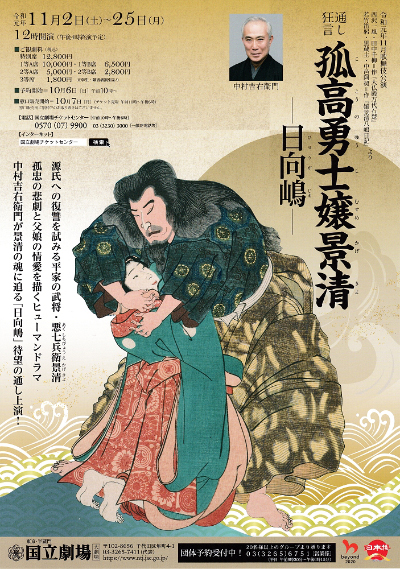 |
| Heisei Nakamuraza (Kitakyűshű) | |
| Dates | 1 ~ 26 November 2019 |
| MatinÚe | |
| Evening | |
| Casting |
Nakamura Kankur˘, Nakamura Shichinosuke, Band˘ Yajűr˘, Nakamura Shid˘, Kataoka Kamez˘, Nakamura Hashinosuke, Nakamura Tsurumatsu, Nakamura Toranosuke, Nakamura Kamenoj˘ |
| Comments |
The Heisei Nakamuraza is in Kitakyűshű in Fukuoka Prefecture. First time since the end of the Heisei era and first time in Kyűshű! The temporary koshibai look-alike theater is built in the precincts of the Kokura Castle. These performances celebrate the 60th anniversary of the reconstructiojn of the keep of this castle in 1959.
|
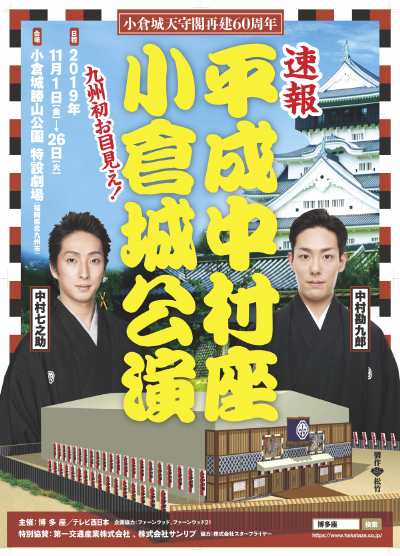 |
| Shinbashi Enbuj˘ (T˘ky˘) |  |
| Dates | 6 October ~ 25 November 2019 SűpÔ Kabuki Sekando Super Kabuki II |
| Program |
Shinpan Oguri |
| Casting |
Ichikawa Ennosuke, Nakamura Hayato, Band˘ Shingo, Ichikawa Monnosuke, Ichikawa Emisabur˘, Ichikawa Emiya, Ichikawa Omez˘, Ichikawa En'ya, Ichikawa Juen, Ichikawa K˘tar˘, Nakamura Fukunosuke, Ichimura Takematsu, Nakamura Tamatar˘, Ichikawa Otora, Ichikawa Ukon, Asano Kazuyuki, Kashima Noritoshi, Ishibashi Sh˘ji, Shimomura Ao, Ishiguro Hideo, Takahashi Y˘ |
| Comments |
The SűpÔ Kabuki Sekando drama "Shinpan Oguri" is a revised version of 1991 SűpÔ Kabuki drama "Oguri".
|
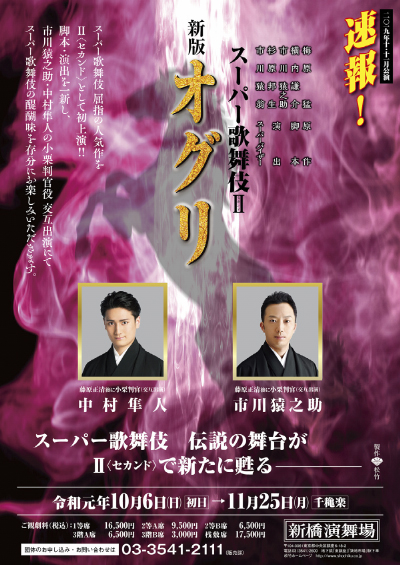 |
| Eirakukan (Toyooka) |  |
| Dates | 4 ~ 10 November 2019 Eirakukan ďkabuki Eirakukan Grand Kabuki |
| Program |
D˘j˘ji Gonichi no Kane Kuy˘ Odoke Niwaka Ataka no Shinseki |
| Casting |
Kataoka Ainosuke, Nakamura Kazutar˘, Kamimura Kichiya, Sawamura S˘nosuke |
| Comments |
This is the 12th Kabuki program at the Eirakukan, a renovated traditional theater built in the city of Toyooka (prefecture of Hy˘go). The first item in the program is a newly-created Kabuki d˘j˘jimono drama. The second item is Kawatake Mokuami's rarely-staged dance-drama "Odoke Niwaka Ataka no Shinseki", which was staged for the last time July 1993 at the Nakaza. |
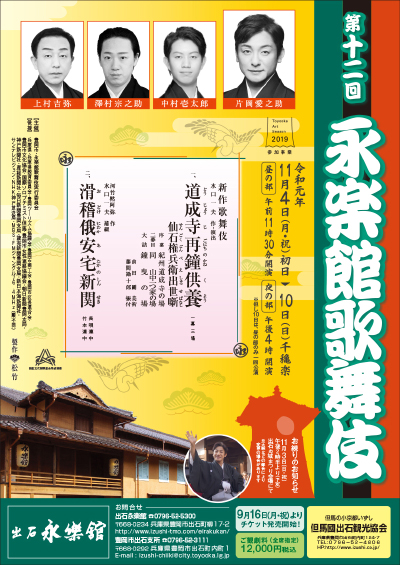 |
|
|||
| Dates | 30 October ~ 4 November 2019 Band˘ Tamasabur˘ Eiz˘ x Buy˘ K˘en Band˘ Tamasabur˘ Image and Dance Performances |
||
| Program |
Y˘kihi |
||
| Casting |
Living National Treasure Band˘ Tamasabur˘ |
||
| Comments |
A special Buy˘ program starring the amazing Living National Treasure onnagata Band˘ Tamasabur˘ in Yamaga at the Yachiyoza, a traditional wooden-built theater. There will be a mix of video projection (with video sequences coming from the high-quality Shinema Kabuki, "Cinema Kabuki") and real dancing on stage.
|
||
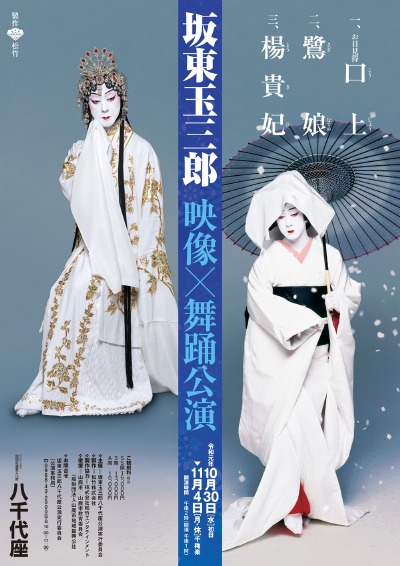 |
|
|||
| Dates | 9 ~ 25 November 2019 ABKAI2019 Ebikai 2019 |
||
| Program |
Daiissh˘ FINAL ~ SANEMORI |
||
| Casting |
Ichikawa Ebiz˘, Ichikawa Udanji, Nakamura Kotar˘, Ichikawa Kudanji, ďtani Hiromatsu, Nakamura Baika |
||
| Comments |
Fifth edition of the ABKAI (Ebikai in Japanese) and first chapter (daiissh˘ in Japanese) of the final round of ABKAI performances, a gala for the young star Ichikawa Ebiz˘, who performs in a newly-created drama based on the classic "Genpei Nunobiki no Taki" and the story of the warrior Sait˘ no Sanemori. |
||
 |
|
|
| Contact | Main | Top | Updates | Actors | Plays | Playwrights | Programs | Links | FAQ | Glossary | Chronology | Illustrations | Prints | Characters | Derivatives | Theaters | Coming soon | News |
